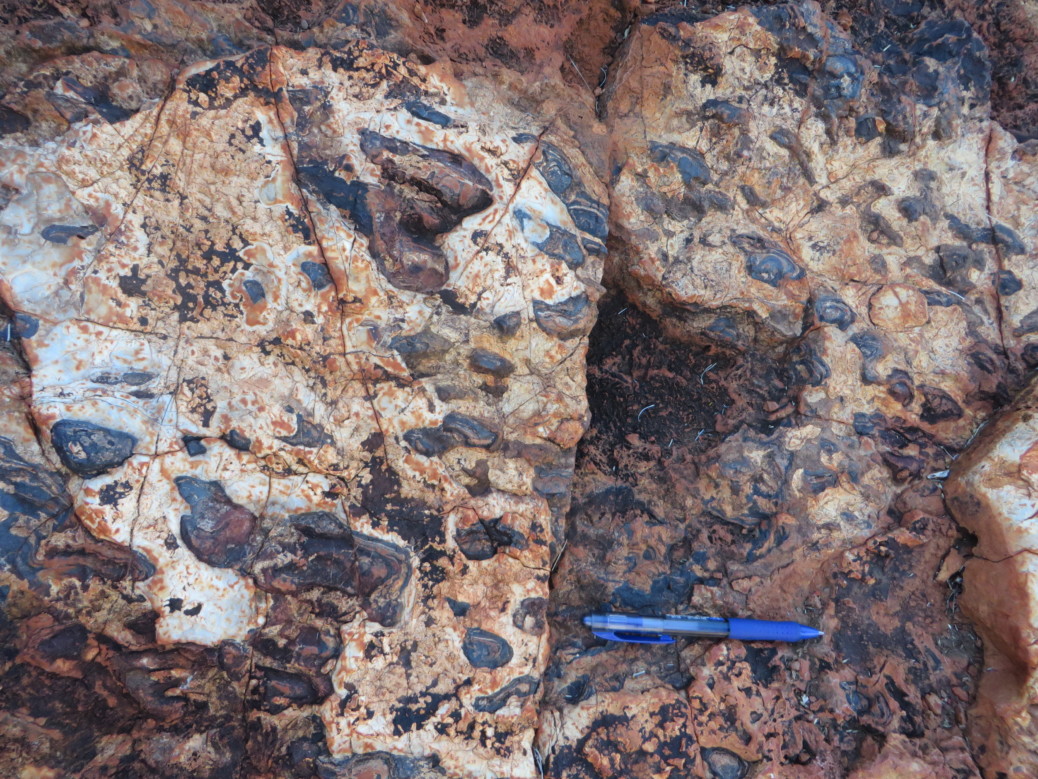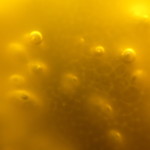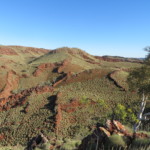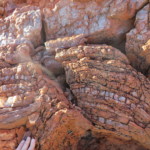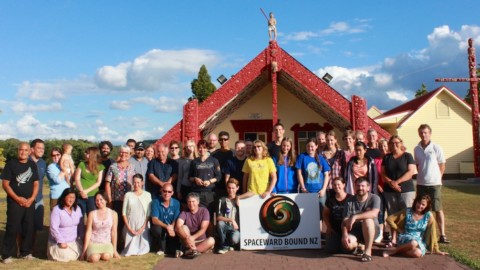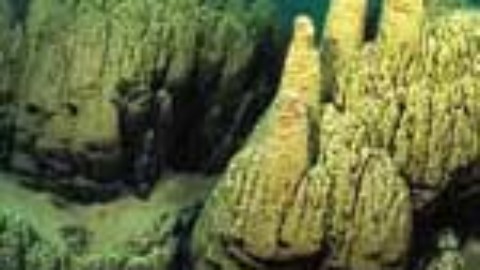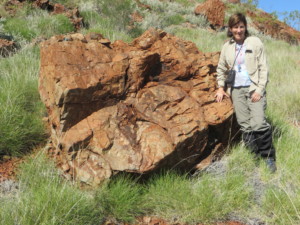
Professor Kathy Campbell in the Pilbara, Western Australia, with ~3.5 billion year old pillow basalts. Photo: T. Djokic.
Professor Kathy Campbell from The University of Auckland is the co-author of a paper published in Nature Communications in May 2017 that pushes the evidence for the oldest life on land back to 3.48 billion years ago. Campbell and her team of collaborators from Australia, Argentina, the U.S. and France have just been awarded a 2017 Royal Society Te Apārangi Marsden Fund grant for the research project ‘Some Liked it Hot: Searching for Early Life in Terrestrial Hot Springs’ to drill fresh rock core in the Pilbara region of Western Australia to obtain high-resolution geochemical, mineralogical and textural data to tease out how and where earliest terrestrial life lived.
Scientists believe life began sometime around 4 billion years ago, perhaps in deep sea hydrothermal vents or alternatively on land, in a version of Charles Darwin’s “warm little pond”. The deep sea hypothesis has been popular for 30 years but some believe life could have taken hold in terrestrial hot springs on an emergent land surface.
One of these “go-to” places where scientists make pilgrimages to marvel at early life is in a well preserved and very ancient piece of Earth’s crust, the Pilbara craton of Western Australia. Stromatolites – layered masses of microbes and sediments – are relatively commonplace, preserved in stone of the Dresser Formation (3.48 billion years old). And while it has been known for a long time that the Dresser contains examples of very early life, it was originally believed that these were marine-based life forms.
However, this team of University of New South Wales and University of Auckland geoscientists looked beyond the obvious and poured over Dresser rocks to take a closer look. This new discovery is special because it brings together evidence that the stromatolites and other purported microbial and features in the Dresser Formation evolved on land, within a volcanic caldera (Van Kranendonk et al., 2008). The key evidence for the presence of a paleo-geothermal system at the Earth’s surface is the recognition of geyserite, a silica-rich, densely layered and knobby or finger-like rock that forms only in the hot vent areas (~75-100 degrees Celsius) of terrestrial hot springs (Campbell et al., 2015a). Geyserite was found together with already known and newly discovered biosignatures in the Nature Communications article, which took a new look at a very old place. The rocks are deemed to have formed in or near river and lake sediments that hosted the ancient geothermal system, pushing back the geological record of hot springs by 3 billion years and the record of life on land by up to 580 million years. Now the new funding from the New Zealand Marsden Fund will allow drilling of these especially old hot springs to get at fresh samples about 70 m beneath the weathered, rusty red surface of the Australian Outback.

Scale bar measurements indicated. (a) High resolution gigapan image of Dresser geyserite. Inset boxes are figure parts (b,c,d). Laminae overgrowth stages; s1 and s2 represented by white dashed lines. Ferruginous material (red arrows) contains inferred gas bubbles; see below. Scale bar, 2 mm. Micrographs in PPL (b–f). (b) Botryoidal textures display laminae onlap/offlap (red arrow), separated by siliceous equigranular troughs (white arrow) overlain by fine, planar laminae (scale bar, 1 mm). (c) Botryoidal–columnar textures overlain by planar (black dashes), slumped (red arrow) laminae. Scale bar, 1 mm. (d) Overgrowth (e1) with outward and downward facing botryoids (white arrows). Quartz (Qz) and barite (B), infill and cross-cut laminae (scale bar, 1 mm). (e) Close-up of light/dark microlaminae in Dresser geyserite. Inset box of figure part (i). Scale bar, 50 μm. (f) Modern geyserite with botryoidal microlaminae (red arrow), Geysir, Iceland. Analogous to (b). Scale bar, 1 mm. (g) Slumped laminae of <100-year-old geyserite, Geyser Valley, New Zealand. Analogous to c. Scale bar, 1 cm. (h) Pool rim overgrowth of geyserite with outward facing botryoids (arrows), Geyser Valley, New Zealand. Analogous to d. Scale bar, 2 cm. (i) SEM-EDS element maps showing light bands enriched in K–Al alternating with dark bands enriched in Ti, identified as kaolinite+illite and anatase, respectively, from Raman spectroscopy and XRD analysis; see Supplementary Figs 2–6 (scale bar, 50 μm). (Djokic et al. 2017)
The New Zealand connection – modern analogue ‘extreme environments’
Back in New Zealand, where the most ancient rocks are only a mere ~500 million years old, this discovery has very special meaning – the research team believes that the ancient environments now fossilised in Western Australia were very similar to what we see around hot springs in Rotorua today, and we need look no further than in our backyard, for example at Orakei Korako where colourful microbial mats thrive in active hot springs. Studying these places now, because they are presently depositing minerals upon and within living microbial mats and their sticky milieu (i.e., exopolymeric substances, or EPS – microbially secreted ‘slime’ to the layperson), can bring further understanding to the extreme conditions under which early life flourished.
In February 2016, UNSW team members joined University of Auckland collaborators for a field trip to observe the formation mechanisms and role of microbes and mineralisation (in this case, silica discharging from the thermal waters) at varied active hot springs of the Rotorua area. For example, at Orakei Korako (or Hidden Valley) they encountered a large sheet of cyanobacteria (yellow) in gooey EPS, growing happily under a summer sun in moderately warm (~50 degrees Celsius) thermal waters, trapping zillions of bubbles of oxygen formed from photosynthetic microbial processes. Because the mats are constantly bathed in silica-rich thermal fluids, bubbles and microbes can become entombed in the siliceous hot spring deposits (sinter) to create a solid rock record of once ancient and, like in the Pilbara, long-gone geothermal activity.
- A fresh summer growth of Leptolyngbya like cyanobacterial mat with yellow carotenoid (UV protection) pigment at Orakei Korako geothermal area
- Numerous bubbles of oxygen – by product of photosynthesis by the mats – trapped in sticky, jelly-like EPS. Photo: T. Djokic.
- Detail of oxygen bubbles trapped in cyanobacterial mats and their exuded EPS. Photo: T. Djokic.
Similar bubbles are reported in the paper; see figure below (Djokic et al., 2017), and are currently under further detailed microscope and mineralogic study. This ‘petrified’ version, frozen in time, and lined and filled with various minerals from the Dresser Formation, is believed to be analogous to what can be observed forming in modern hot springs like at Orakei Korako.

Inferred bubbles in the Dresser Formation (a-d) and actual bubbles in microbial sinter of different ages (e-g). Scale bar measurements indicated. Micrographs in PPL (a,b). (a) Spherical to subspherical inferred bubbles filled with quartz (Qz) and barite (B). Scale bar, 90 μm. Inset box of (b) inward radiating anatase crystal splays from bubble rim (dashed line). Scale bar, 22 μm. (c) SEM-EDS element map data of Ti concentration in crystal splay (Cs) along bubble rim (dashed line). Scale bar, 9 μm. (d) Quartz (Qz) and barite (B) cutting bubble wall. Scale bar, 22 μm. (e) Oxygen bubbles in modern EPS of a mid-apron cyanobacterial mat, Orakei Korako, New Zealand. Scale bar, 2 mm. (f) Spherical to subspherical fossil bubbles (arrows) preserved in wavy laminated sinter, representing a silicified microstromatolite+EPS typical of mid-temperature sinter apron pools from the recently extinct Beowawe hot spring, Nevada. Scale bar, 200 μm. (g) Microbial palisade3 fabric with spherical structures, representing silicified gas bubbles in 15 Ka sinter, Tahunaatara, Taupo Volcanic Zone, New Zealand. Scale bar, 250 μm. (Djokic et al., 2017)
Other biosignatures
One of the holy grails of astrobiology is the study of extreme environment analogues for understanding early life on Earth and perhaps that on other worlds within the Solar System. When biosignatures in extreme environments turn to stone under rapid, early mineralisation, akin to what occurs along hot spring discharge channels, their long-term preservation pathways can be tracked into the geological record.
In the Dresser Formation rocks, there are wavy, layered, aggrading horizons that appear very similar to terracette (mini-terrace) deposits forming on hot spring discharge aprons that are building up the solid sinter deposit. In modern hot springs, these distal, i.e. relatively cool (<40 degrees Celsius), terracettes are covered in dense, pillar-like horizons (or ‘palisades’) of microbial filaments (Calothrix cyanobacterium). As the silica deposits upon the terraced surface of the spring discharge channels and pools, the sinter terracettes grow upward and outward to form distinctive internal growth features replete with microbial palisade textures.
In the image below, the rock on the left shows palisade fabric from the Pilbara (the mini-terrace ‘lips’, or rims, are marked with large blue arrows) – Underneath the palisade fabric there is another kind of inferred microbial fabric of dark, bushy dendritic morphology.
The rock (sinter) on the right from Te Kopia, New Zealand, illustrates upwardly and outwardly growing terracette rims, filled with vertical palisade fabric of silicified microbes – it is between 1800-3500 years old (Martin et al., 2000). Large blue arrows mark the upward and outward growth lips of terracette margins.
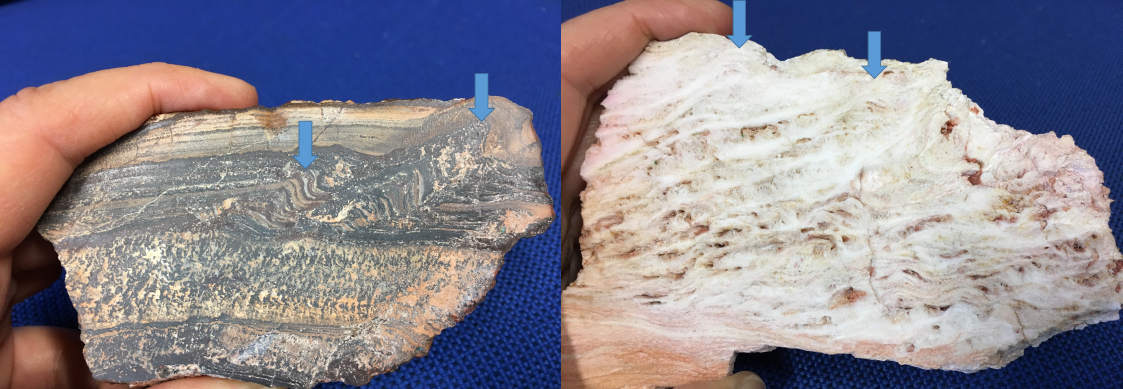
In 1889, Weed was the first to recognise palisade textures in modern hot-spring environments at Yellowstone National Park (USA). He described them as ‘‘fibrous’’ layers of silica-encrusted ‘‘algous vegetation”, now known to be formed by cyanobacteria. In Devonian sinters (~400 million years) from the Drummond Basin, Australia, Walter et al. (1996, 1998) reported tubular microfossils with diameters of 5–8 microns and 10–12 microns, akin to thermal spring filament diameters characteristic of modern New Zealand examples. It is unknown what kind of microbes formed the palisade fabric in the Dresser Formation, but their morphologies are similar in character to much younger microbial sinters. Palisade fabric is common in other fossil hot-spring deposits such as the Devonian Windyfield chert, Scotland (Fayers and Trewin, 2003), Jurassic sinter in Patagonia (Guido and Campbell, 2009, 2011, 2014), and Quaternary sinters in the TVZ (New Zealand) at Umukuri (Campbell et al., 2001), Tahunaatara (Campbell et al., 2003), Mangatete (Drake et al., 2014), Te Kopia (Lynne and Campbell, 2003), and Orakei Korako (Lynne and Campbell, 2003, 2004). Their preservation into the “deep-time” geological record of hydrothermal settings was studied by Campbell et al. (2015b).
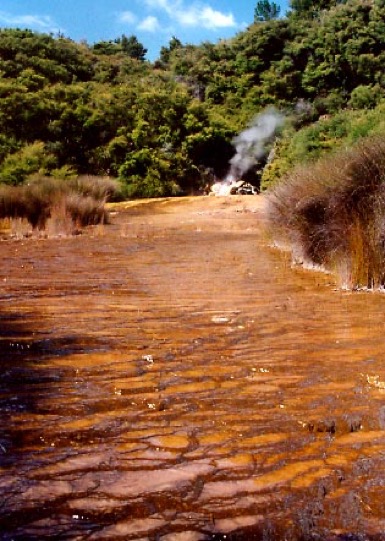
Distal discharge apron building up microbial palisade fabric (brown) in stacked terracettes, Healy’s Bore 2 spring at Tokaanu, TVZ
An example of a modern sinter discharge apron is shown here from Healy’s Bore 2 spring at Tokaanu, Taupo Volcanic Zone (TVZ), New Zealand, with small mini-terraces (terracettes) building up a microbial palisade fabric (brown Calothrix cyanobacterium; Campbell et al., 2015b) in the distal reaches (<40 degrees Celsius) of the geothermal outflow. This colourful scene has been frozen in time inside the rocky outcrops of the Pilbara and at Te Kopia. Studying young extreme environment analogues helps us imagine steaming hot springs along creeks and near lake shorelines of early Earth that harboured early life in plausibly similar ways, oblivious to the fact that human beings would some 3+ billion years later marvel at their tremendously long history.
How life appeared is as yet an unsolved mystery, but this discovery of significantly older siliceous hot spring rocks – sinter, including the near-vent form known as geyserite – suggests that life was flourishing in terrestrial (on land) early Earth environments by 3.5 billion years ago.
- Vertical cross-section through cyanobacterial mat (silicified, ~60 years old), with orange/brown pigment still preserved – on discharge apron in a terracette, Healy’s Bore 2 spring at Tokaanu, TVZ
- 15,000 year old palisade fabric (stacked layers of vertical filaments) preserving fossilized terracettes and containing trapped gas bubbles (photosynthetic gas release by the mats). Tahunaatara, New Zealand
Why is this discovery important
Previously, the world’s oldest evidence for microbial life on land came from 2.7- 2.9 billion year old deposits in South Africa containing organic matter-rich ancient soils. This new discovery:
“…indicate[s] that life was inhabiting the land much earlier than previously thought, by up to about 580 million years”
“The discovery of potential biological signatures in these ancient hot springs in Western Australia provides a geological perspective that may lend weight to a land-based origin of life.”
“Our research also has major implications for the search for life on Mars, because the Red Planet has ancient hot spring deposits (Ruff and Farmer, 2016) of a similar age to the Dresser Formation in the Pilbara.”
quotes from PhD student Ms Djokic (UNSW), the first author of the paper.
- Tops of Dresser Formation domal stromatolites
- View of Pilbara landscape showing subsurface hydrothermal veins – feeders to the overlying geothermal system
- Dresser Formation rock details with domal stromatolite
Read more
Here is the abstract quoted from Nature.com, click here for the link to the full paper.
“The ca. 3.48 Ga Dresser Formation, Pilbara Craton, Western Australia, is well known for hosting some of Earth’s earliest convincing evidence of life (stromatolites, fractionated sulfur/carbon isotopes, microfossils) within a dynamic, low-eruptive volcanic caldera affected by voluminous hydrothermal fluid circulation. However, missing from the caldera model were surface manifestations of the volcanic-hydrothermal system (hot springs, geysers) and their unequivocal link with life. Here we present new discoveries of hot spring deposits including geyserite, sinter terracettes and mineralized remnants of hot spring pools/vents, all of which preserve a suite of microbial biosignatures indicative of the earliest life on land. These include stromatolites, newly observed microbial palisade fabric and gas bubbles preserved in inferred mineralized, exopolymeric substance. These findings extend the known geological record of inhabited terrestrial hot springs on Earth by ∼3 billion years and offer an analogue in the search for potential fossil life in ancient Martian hot springs.”
Altmetrics score for the article is: 1062.
Professor Kathy Campbell had an interview with Kathryn Ryan on Nine to Noon
http://www.radionz.co.nz/national/programmes/ninetonoon/20170510
And on Radio Live:
News media coverage:
More projects funded in diverse topics important for New Zealand in 2017 Marsden funding round (Press release Royal Society)
Marsden Awards 2017 (Press release Royal Society)
Could life have originated on land? (Press release Royal Society)
The Mists of Time (NZ Geo)
Marsden Award Winner: Marsden Fund marvels: 10 amazing new studies, Could life have originated on land? (New Zealand Herald)
Oz, NZ scientists reveal oldest life on land (New Zealand Herald)
Oldest Evidence of Life on Earth Possibly Found in Australian Rocks (Live Science)
Oldest evidence of life on land found in 3.48-billion-year-old Australian rocks (Phys.org)
Oldest evidence of life on land discovered in Australia (Sydney Morning Herald)
Oldest evidence of life on Earth is found in 3.5 billion-year-old Australian rocks: Discovery proves that Charles Darwin was RIGHT about its origins (Daily Mail)
3.5-billion-year-old fossils hint life evolved in pond, not sea (New Scientist)
Australian Fossils Hint At Where To Search For Life On Mars (NPR)
Evidence of ancient life in hot springs on Earth could point to fossil life on Mars (The Conversation)
References
Campbell, K.A., Buddle, T.F., and Browne, P.R.L. Late Pleistocene silica sinter associated with fluvial, lacustrine, volcaniclastic and landslide deposits at Tahunaatara, Taupo Volcanic Zone, New Zealand. Trans R Soc Edinb Earth Sci 94:485–501.(2003)
Campbell, K. A., Guido, D.M., Gautret, P., Foucher, F., Ramboz, C., Westall, F. Geyserite in hot-spring siliceous sinter: Window on Earth’s hottest terrestrial (paleo) environment and its extreme life. Earth-Science Reviews 148, 44-64 (2015a).
Campbell, K. A., Lynne, B. Y., Handley, K. M., Jordan, S., Farmer, J. D., Guido, D. M., Foucher, F., Turner, S., and Perry, R.S., Tracing Biosignature Preservation of Geothermally Silicified Microbial Textures into the Geological Record Astrobiology 15 /10, 858-882 (2015b).
Campbell, K.A., Sannazzaro, K., Rodgers, K.A., Herdianita, N.R., and Browne, P.R.L. Sedimentary facies and mineralogy of the Late Pleistocene Umukuri silica sinter, Taupo Volcanic Zone, New Zealand. Journal of Sedimentary Research 71:727–746. (2001)
Fayers, S.R. and Trewin, N.H. A review of the palaeoenvironments and biota of the Windyfield chert. Trans R Soc Edinb Earth Sci 94:325–339. (2003)
Guido, D.M. and Campbell, K.A. Jurassic hot-spring activity in a fluvial setting at La Marciana, Patagonia, Argentina. Geological Magazine 146:617–622. (2009)
Guido, D.M. and Campbell, K.A. Jurassic hot spring deposits of the Deseado Massif (Patagonia, Argentina): characteristics and controls on regional distribution. Journal of Volcanology and Geothermal Research 203:35–47. (2011)
Guido, D.M. and Campbell, K.A. A large and complete Jurassic geothermal field at Claudia, Deseado Massif, Santa Cruz, Argentina. Journal of Volcanology and Geothermal Research 275:61–70. (2014)
Lynne, B.Y. and Campbell, K.A. Diagenetic transformations (opal-A to quartz) of low- and mid-temperature microbial textures in siliceous hot-spring deposits, Taupo Volcanic Zone, New Zealand. Can J Earth Sci 40:1679– 1696. (2003)
Lynne, B.Y. and Campbell, K.A. Morphologic and mineralogic transitions from opal-A to opal-CT in lowtemperature siliceous sinter diagenesis, Taupo Volcanic Zone, New Zealand. Journal of Sedimentary Research 74: 561–579. (2004)
Martin R., Mildenhall D., Browne P.R.L., Rodge K.A, The age and significance of in-situ sinter at Te Kopia thermal area. Geothermics, 29, 367-375 (2000b).
Van Kranendonk, M. J., Philippot, P., Lepot, K., Bodorkos, S., Pirajno, F. Geological setting of Earth’s oldest fossils in the ca. 3.5 Ga Dresser Formation, Pilbara Craton, Western Australia. Precambrian Research 167, 93-124 (2008).
Walter, M.R., Des Marais, D., Farmer, J.D., and Hinman, N.W. Lithofacies and biofacies of mid-Paleozoic thermal spring deposits in the Drummond Basin, Queensland, Australia. Palaios 11:497–518. (1996)
Walter, M.R., McLoughlin, S., Drinnan, A.N., and Farmer, J.D. Paleontology of Devonian thermal spring deposits, Drummond Basin, Australia. Alcheringa 22:285–314. (1998)
Weed, W.H. On the formation of siliceous sinter by the vegetation of thermal springs. Am J Sci 37:351–359. (1889)

